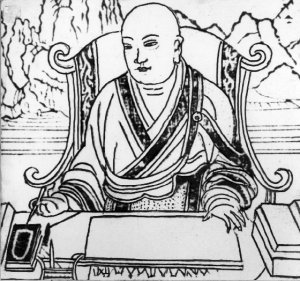Chinese Traveler Hiun-Tsiang
by K. L. Kamat
First Online: May 01, 2001
Page Last Updated: December 07, 2024
The world outside India was always in search of this magic land. The Chinese were attracted to India for her fabulous wealth of learning since ancient times. Hiuen-Tsiang (a.k.a. Huen Tsang, 603-664 A.D.) was one of the outstanding Chinese scholars who visited India in search of knowledge.
He was born at Ch'in Liu in the province of Hunan. At a young age of thirteen years he was ordained as a Buddhist priest, in the Tsing-tu temple. He traveled extensively, in China, is search of an able teacher and when he failed he decided to visit India. In 630 A.D. at age of twenty six years he commenced his long dreamed journey without bothering, to obtain the permission of the emperor, or for his personal safety during a prolonged and tedious journey.
© K. L. Kamat

Hiun Tsang at Nalanda University
He traveled extensively in India. He passed through Kashmir valley, visited Takshashila, and reached Mathura, where he saw the sacred traces of Lord Buddha at Kashi. He went to Kapilavastu, Kushinagar, Pataliputra, Vaishali, Mahabodhi, and stayed at the famed Nalanda university. Tsinag then visited Rajgir and Nepal. He also toured South India and paid a visit to Sri Lanka.
Hiuen Tsiang's visit to Nalanda Mahavihara meant the fulfillment of his life-long wishes which brought him to India. There he found profound learning, devotion, warm and cordial hospitality. Under the able guidance of Shilabhadra and Buddhabhadra, he was able to extend his scholarship in a wider sense than he could have done elsewhere. He could study subjects like logic, grammar, linguistics, medicine, crafts and the Vedas in great detail.
He returned by the same route by which he had come to India. He collected very valuable information and manuscripts. Unfortunately while crossing the Indus river on the way back, his boat capsized and a number of documents were lost. However, some of these he was able to recover from the libraries at Kusha and Kashghar monasteries.
In the year 645 A.D. he was back in China. He had carried with him relics, golden and sandalwood statues of Lord Buddha, 224 books of the sutras, 192 Shastras, 15 works of the Sthavira schools, 67 books of the Sarvastivada school, and 17 works of the Kasyapiya school. The emperor, although was upset by Hieun Tsiang's actions earlier, gave a him a hero's welcome upon return. The emperor also built a pagoda at the southern gate of the Hogn-Fu temple in Si-gan-fu, in which Hiuen Tsinag's entire collection is protected and preserved. This noble act of the Chinese emperor enables the scholars of Buddhist studies could make use of this extremely valuable source material even today.
![]()
See Also:
- Crossing of the Indus River -- memoirs of Chinese traveler Fa-Hien
- India though the eyes of foreign travelers